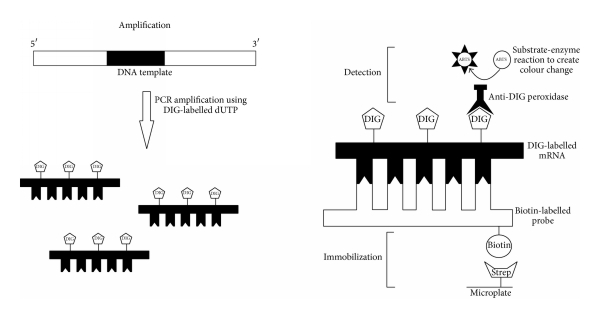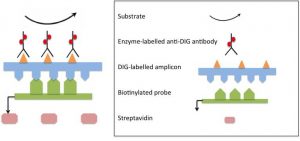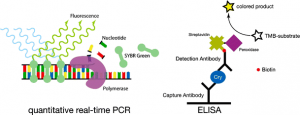
Abstract
Enzyme-linked immunosorbent assay-polymerase chain reaction (PCR-i-ELISA) is an immunodetection method that can quantify the PCR product directly after immobilization of biotinylated DNA on a microplate. This method, which detects nucleic acid instead of protein, is a much more sensitive method compared to the conventional PCR method, with a shorter analytical time and lower detection limit.
Its high specificity and sensitivity, coupled with its semi-quantitative capability, give it enormous potential to serve as a powerful screening tool in various industries, such as medical, veterinary, and agricultural. With recent advances in PCR-ELISA, the assay is expected to become more widely recognized for its rapid and sensitive detection limit, which could improve overall diagnostic time and quality.
Protecting Livestock and Poultry Operations Begins with Routine supervision. Veterinarians and producers rely so heavily on enzyme-linked immunosorbent assay (ELISA) and polymerase chain in real-time reaction tests (PCR) for specific reasons at specific times.

The results are used to:
• Identify infected animals in eradication programs.
• Carry out surveillance of transmitting agents in transport vehicles.
• Confirm the negative status of export animals.
• Select effective treatments.
• Early detection of emerging diseases.
• Verify the effectiveness of vaccination.
Use ELISA to:
- Confirm herds are free of important pathogens.
- Evaluate the progression of a herd through the elimination of pathogens.
- Manage herds with endemic diseases to reduce the impact of disease on health and production.
Use PCR to:
• Identify the DNA or RNA of a given pathogen.
• Determine the status of animals with clinical signs or symptoms.
• Assess the status of animals intentionally exposed to a pathogen for acclimatization.
Use ELISA and PCR together to:
- Confirm exposure to a pathogen in low prevalence herds.
- Identify the DNA or RNA of disease agents when clinical signs are lacking.
- Clarify the cause of the disease when you are concerned about a misdiagnosis or when multiple agents are present.
Designing your programs, choosing your tests
IDEXX will work with you to design and implement your programs. Our instruments and software provide reliable results for more than 50 of the most prevalent diseases of livestock and poultry. In addition, global distribution and manufacturing, backed by expert technical service and international regulatory expertise, ensure a prompt response wherever you do business.

ELISA Formats
ELISAs are divided into three main formats: indirect, blocking (competitive) and antigen capture (direct).
Indirect format:
In the indirect format, the sample the antibody intercalates between the antigen coated on the plate and an enzyme-labelled anti-species globulin conjugate. The addition of a chromogenic enzyme-reactive substrate causes the colour to develop. This colour is directly proportional to the amount of bound sample antibody. The more antibody present in the sample, the stronger the colour development in the test wells. This format is suitable for determining the total level of antibodies in samples.
Blocking (competitive) format:
In this format, the Specific antibodies in the sample compete with or block, the enzyme-labelled specific antibody in the conjugate. The addition of a chromogenic enzyme-reactive substrate causes the colour to develop. This colour is inversely proportional to the amount of bound sample antibody. The more antibodies there are in the sample, the less colour development in test wells.
Antigen capture format (direct):
In the antigen capture format, the antigen in the sample is sandwiched between the antibodies coated on the plate and an enzyme labelled conjugate. The antibody conjugate can be monoclonal or polyclonal. The addition of a chromogenic enzyme-reactive substrate causes the colour to develop.
